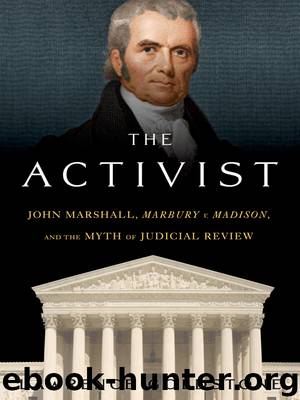The Activist by Lawrence Goldstone

Author:Lawrence Goldstone
Language: eng
Format: epub
Publisher: Bloomsbury Publishing Plc
Published: 2009-12-30T16:00:00+00:00
Marshall, who had intended to return to his law practice and land speculation when Adams’s term ended, was not altogether thrilled with the appointment. Until he himself joined its ranks, strong indications are that Marshall shared Hamilton’s Federalist 78 assessment of the judicial branch as “beyond comparison, the weakest of the three departments of power.” Placed in charge of the government’s transition from Philadelphia to the District of Columbia by Adams, Secretary of State Marshall thought so little of the Supreme Court that he either did not notice or did not care that planners of the new capital had made no provision for its accommodations. No chamber had been set aside for the Court to meet, nor were any plans in place for a law library, office space, housing for the six justices, or even staff. Marshall received two letters from the district commissioners, one in December 1800 and the other in January 1801, asking him to recommend remedies, but he apparently did not reply to either until he realized it was his own working space that he had been ignoring.
On January 20, 1801, Marshall’s nomination came before the Senate and the courts bill passed the House. With the February term of the Court due to begin in just over a week, “The Speaker laid before the House a letter from the Commissioners of the city of Washington, requesting that an arrangement may be made for the lodging of the Supreme Court of the United States, in the Capitol.”32 Three days later, the House “Resolved that leave be given to the Commissioners of the city of Washington to use one of the rooms on the first floor of the Capitol for holding the present session of the Supreme Court of the United States.”33 The Senate acceded to the resolution the following day.
Marshall may well have regretted his inattention to the Court when he saw the room that had been assigned to it, a noisy, unfinished Committee Room 2 on the Senate side of the first floor, next to the main staircase, “meanly furnished and very inconvenient.”34 The justices were to sit at desks on a raised platform instead of behind a bench, and the Court had still not been assigned a secretary or staff. The Supreme Court of the United States lacked even an official reporter, since the man who had held the job in Philadelphia, Alexander Dallas, had refused to abandon his sophisticated city to pioneer in the new capital.
Far more significant than second-rate accommodations was that the Court itself had sunk to such low repute. The one time the Court had asserted itself on a constitutional question—the Chisholm case—Congress had responded by passing the Eleventh Amendment to nullify the ruling. While in theory most legislators and members of the executive acknowledged that the Supreme Court should have some role in constitutional interpretation, after a decade, the nature of that role had not yet begun to be determined. Judicial review as it was to be established in Marbury was
Download
This site does not store any files on its server. We only index and link to content provided by other sites. Please contact the content providers to delete copyright contents if any and email us, we'll remove relevant links or contents immediately.
Day by Elie Wiesel(2243)
The Age of Genius by A. C. Grayling(2173)
Gideon's Spies: The Secret History of the Mossad by Gordon Thomas(1950)
The Gulag Archipelago (Vintage Classics) by Aleksandr Solzhenitsyn(1725)
FATWA: Hunted in America by Pamela Geller(1720)
Columbine by Dave Cullen(1495)
Examples & Explanations: Administrative Law by William F. Funk & Richard H. Seamon(1326)
The Rule of Law by Bingham Tom(1318)
Men Explain Things to Me by Rebecca Solnit(1313)
Anatomy of Injustice by Raymond Bonner(1268)
Three Cups of Tea by Greg Mortenson(1256)
ADHD on Trial by Michael Gordon(1239)
That Every Man Be Armed by Stephen P. Halbrook(1237)
Gideon's Spies by Gordon Thomas(1214)
Palestinian Walks by Raja Shehadeh(1141)
The Source by James A. Michener(1134)
Fast Times in Palestine by Pamela Olson(1115)
Nothing to Envy by Barbara Demick(1040)
Constitutional Theory by Carl Schmitt(1034)
